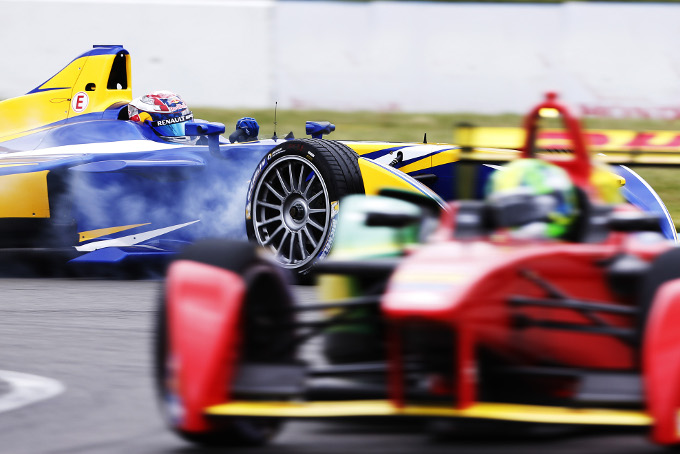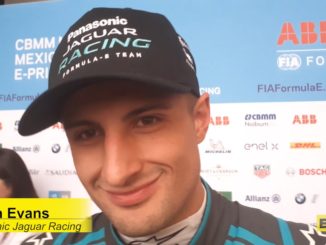Fonte: Formula E
Donington Park, Gran Bretagna. 13 Agosto 2015. Sebastien Buemi e il team Renault hanno rubato i titoli dopo il primo test pre-campionato a Donington Park, ma che cosa vedremo realmente nella prossima stagione?
Buemi è stato il più veloce, ma Daniel Abt è stato il più veloce nel primo e nel secondo settore, prima che il traffico in corrispondenza delle curve finali l’hanno rallentato. Con solo una quantità limitata di giri disponibili in versione qualifica, il tedesco non poteva fare un altro tentativo per salire in classifica. Ma il tempo sul giro non è quello che interessa in questi test pre-stagionali – ma di fatto sono le nuove modifiche tecniche.
Per la seconda stagione, le squadre saranno in grado di avere il proprio propulsore. Il propulsore ed essenzialmente i componenti che prendono energia dalla batteria per trasmetterla alle ruote. Fondamentalmente questo comprende l’inverter, il motore elettrico ed il riduttore. Poiché ogni squadra ancora utilizza la stessa batteria, non aspettatevi troppa differenza nel giro secco. La chiave è l’efficienza.
 Le differenze più evidenti tra i vari produttori è il numero di marce. Anche se i motori elettrici hanno coppia istantanea, gli ingranaggi possono ancora rivelarsi vantaggiosi quando si tratta di massimizzare questa potenza. La macchina dello scorso anno aveva cinque marce avanti, così per il Team Aguri – che sta ancora utilizzando powertrain dello scorso anno – rimarrà la stessa. Nonostante l’uso di un motore McLaren aggiornato, Mahindra è scesa con quattro marce, cosi come Venturi. Nell’altra estremità dello spettro, ci sono NEXTEV TCR e DS Virgin che entrambi hanno deciso di utilizzare un sistema di trasmissione diretta, in modo efficace con una marcia.
Le differenze più evidenti tra i vari produttori è il numero di marce. Anche se i motori elettrici hanno coppia istantanea, gli ingranaggi possono ancora rivelarsi vantaggiosi quando si tratta di massimizzare questa potenza. La macchina dello scorso anno aveva cinque marce avanti, così per il Team Aguri – che sta ancora utilizzando powertrain dello scorso anno – rimarrà la stessa. Nonostante l’uso di un motore McLaren aggiornato, Mahindra è scesa con quattro marce, cosi come Venturi. Nell’altra estremità dello spettro, ci sono NEXTEV TCR e DS Virgin che entrambi hanno deciso di utilizzare un sistema di trasmissione diretta, in modo efficace con una marcia.
In Argentina la scorsa stagione ci sono stati 23 cambi di marcia per giro. Un cambio di marcia dura circa 0,05 secondi, quindi nel corso di un giro la macchina spende 1,15 secondi in folle, senza alcuna potenza da essere trasmessa alle ruote in accelerazione, né rigenerazione in frenata quando bisogna scalare le marce verso il basso per rallentare la macchina. Eliminando la necessità di cambi di marcia potrebbe risparmiare una quantità di tempo prezioso. Il fatto che così tante soluzioni diverse sono state implementate è una delle più interessanti modifiche della nuova stagione. Renault ad esempio, sta utilizzando due ingranaggi, mentre Abt sta impiegando tre. Questi potrebbero essere piccole differenze, ma come abbiamo visto a Londra alla fine della scorsa stagione, vincere il titolo dipende da queste cose.
Queste diverse interpretazioni delle nuove norme creano anche suoni diversi. La macchina DS Virgin è silenziosa e regolare, mentre la macchina Abt ha un fischio acuto in aggiunta al suono normale del motore elettrico. Questo aiuta davvero a dimostrare che la Formula E si è allontanata da essere un monomarca e lo sviluppo è la chiave.
NEXTEV ha avuto un difficile test pre-campionato a Donington. Dopo aver eseguito un periodo di prova con un certo successo fino alle sedute pubbliche, tutto è cambiato il lunedi a Donington. Il campione in carica Nelson Piquet Jr si è fermato in pista per due volte, costringendo la squadra ad inviare i motori a controllare per capire il problema, escludendo i test di martedì.
I suoi problemi, però, impallidivano in insignificanza rispetto ai team Andretti e Trulli. Dopo non aver provato il lunedi, Andretti è sceso in pista il martedì. Simona de Silvestro era al volante, mentre l’auto ha lasciato ai box. La vettura ha fatto il vecchio tornante prima della battuta d’arresto. La bandiera rossa è stata sventolata e il personale del team è andato in pista ad assistere la loro auto. Hanno rimesso la macchina in movimento ancora per altri due curve, prima di un secondo stop. Il processo è stato ripetuto e altri due curve sono state completate, quindi con un riavvio finale la vettura Andretti è tornata ai box, dopo circa 15 minuti in pista. La vettura e il team sono chiaramente dietro la curva di sviluppo in questo momento, ma non c’è dubbio che dovranno aggirare il problema.
Il team di Trulli non è riuscito nel frattempo a scendere in pista nessuno dei due giorni di test. Jarno si è seduto al volante il lunedi, e la macchina si trasferì con i propri mezzi alla pitlane, prima di fermarsi appena fuori dal garage. Il team ha deciso di rinviare il collaudo fino all’arrivo della seconda serie di dati degli esami.
Come sempre con i test pre-campionato, è molto più facile vedere chi è in lotta e chi procede bene. Senza conoscere le percentuali di energia della batteria è impossibile avere qualsiasi conoscenza su cosa il produttore ha creato la soluzione più efficiente. Semplicemente sulla base delle due prove di Donington effettuate finora, si potrebbe concludere che e.dams Renault, Abt e DS Virgin sono più forti, ma ci sono ancora molti chilometri da fare prima che la stagione inizi a Pechino.
In English
Jack in the box: thoughts from test one
Source: Formula E
Donington Park, Gran Bretagna. 13 Agosto 2015. Sebastien Buemi and the Renault team stole the headlines after the first pre-season test at Donington Park, but what did we actually learn about the upcoming season? Buemi was fastest, but Daniel Abt held the fastest first and second sectors, before traffic at the final corners slowed him down. With only a limited amount of qualifying sim laps available, the German couldn’t have another attempt at topping the timesheets. But out and out lap time is not what these pre-season tests – or in fact the new technical changes – are about.
For season two, teams can manufacture their own powertrain. The powertrain is essentially the components that take energy from the battery and make it turn the wheels. Fundamentally this comprises the inverter, electric motor and gearbox. Because each team is still using the same battery, don’t expect too much difference in pure one-lap pace. The key is efficiency.
The most noticeable differences between the various manufacturers is the number of gears. Although electric motors have instant torque, gears can still prove advantageous when it comes to maximising this power. Last year’s car had five forward gears, so for Team Aguri – which is still using last year’s powertrain – that will remain the same. Despite using an upgraded McLaren motor, Mahindra has dropped to using four gears, as has Venturi. At the other end of the spectrum, you have NEXTEV TCR and DS Virgin, who have both decided to use a direct drive system, effectively one gear.
In Argentina last season there were 23 gear changes per lap. A gear change takes roughly 0.05 seconds, so over the course of one lap the car spends 1.15 seconds out of gear, with no power being delivered to the wheels under acceleration, and no regen braking when slowing the car down. Eliminate the need for gear changes, and you could save yourself a valuable amount of time. The fact that so many different solutions have been implemented is one of the most fascinating changes for the new season. Renault for example, is using two gears, while Abt is employing three. These might be small differences, but as we saw in London at the end of last season, winning titles depends on such things.
These different executions of the new rules also create different sounds. The DS Virgin car is quiet and smooth, while the Abt machine has a high-pitched whistle in addition to the regular electric motor sound. This really helps in demonstrating that Formula E has moved away from being a one make series, and development is key. (To hear the new sounds of the cars click here)
NEXTEV had a difficult pre-season test at Donington. Having run a pretty successful test period until the public sessions, it all unravelled on the Monday at Donington. Defending champion Nelson Piquet Jr stopped on track twice, forcing the team to send the motors away to figure out the problem, ruling them out of Tuesday’s running.
Its problems, though, paled into insignificance compared to Andretti and Trulli. After no running on Monday, Andretti made it to the track on Tuesday. Simona de Silvestro was at the wheel, as the car left the pits. The car made it to the Old Hairpin before grinding to a halt. The red flag was thrown, and team personnel hopped in a course car to go and assist. They got the car moving again for another two corners before its next failure. The process was repeated and another two corners were completed, then with one final restart the Andretti car returned to the pits, after around 15 minutes on track. The car and team are clearly behind the development curve at the moment, but there’s no doubt they have the skills to turn it around.
The Trulli team meanwhile failed to get on track at all. Jarno got behind the wheel on Monday, and the car moved under its own power into the pitlane, before coming to a stop just outside the garage. The team have now decided to postpone the shakedown until the second set of test dates.
As ever with pre-season testing, it’s much easier to see who’s struggling than who is running well. Without knowing the battery energy percentages it’s impossible to have any grasp on which manufacturer has created the most efficient solution. Simply on the basis of the two Donington tests so far, you’d have to conclude that Renault e.dams, Abt and DS Virgin are looking strongest, but there’s still a lot of mileage to come before the season starts in Beijing.
no images were found



Commenta per primo